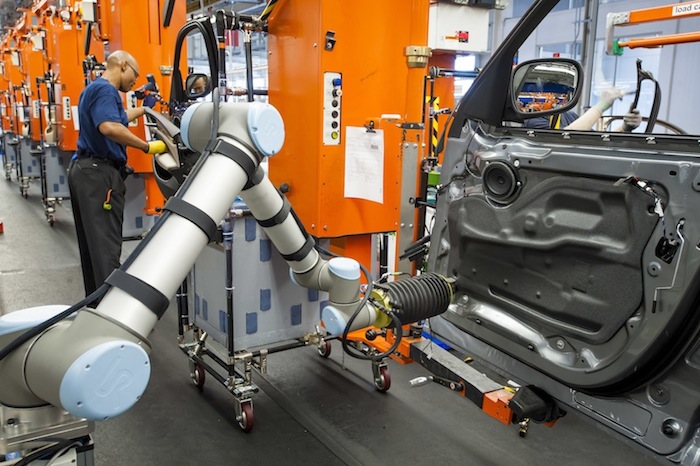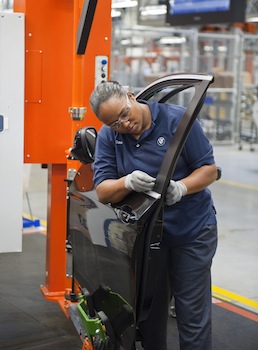How automation is being developed for a wider range of production configurations
 Automation has lent itself to the pattern of high production volumes and product uniformity which is particularly required by OEM vehicle assemblers. That pattern, however, has not remained static. While global production volumes remain high, automation now has to be flexible enough to deal with rapidly changing product configurations – a requirement that is even more pronounced at the supplier level than at the OEMs.
Automation has lent itself to the pattern of high production volumes and product uniformity which is particularly required by OEM vehicle assemblers. That pattern, however, has not remained static. While global production volumes remain high, automation now has to be flexible enough to deal with rapidly changing product configurations – a requirement that is even more pronounced at the supplier level than at the OEMs.
That is very much the view of Roland Spiess, global Tier 1 director for German-based robot supplier Kuka. The nature of the automotive market for a major supplier of automated manufacturing equipment is now one of a distinct divide between the requirements of vehicle assemblers and the next step down in their logistical supply chain. OEMs, Spiess indicates, still order large numbers of standard robots for a limited range of highly specific applications, such as welding or painting. By contrast, the supplier sector – even at Tier 1 level – is characterised by a requirement to satisfy a much greater variety of application tasks both across the sector as a whole and even within individual companies.
As Spiess points out, suppliers will not just be making parts of all sizes, they will also be dealing with different materials, thus requiring robots to handle more diverse tasks such as loading and unloading plastic parts from moulding machines as well as deburring edges on metal components. An increasing trend towards suppliers providing complete sub-systems containing structural elements, electronics, and high-quality surface finishes, means that demand for flexibility in automated manufacturing systems will be considerable.
But, says Spiess, that demand will not be for flexibility at any price. Instead it will be for “flexibility through standardisation” in key elements of the systems they buy. In the case of robots, he continues, those elements are more likely to focus on ‘soft’ aspects such as controllers and programming interfaces rather than purely physical, ‘hard’ counterparts such as motors and gears. However, “energy efficiency, higher output and economical use of floorspace” will be constant factors driving demand.
Integration through flexibility
Floorspace is certainly a factor at Karl Krumpholz Plastics Technology, Germany, which specialises in the manufacture of plastic parts for the automotive industry. The company uses the injection moulding process and seeks to automate both this and succeeding operations to the maximum extent. Since March 2013, Karl Krumpholz has been using the combination of a 2,300-tonne injection moulding machine and a Kuka KR 120 R3900 ultra shelf-mounted robot to produce several components for the plastic bumper system of a German commercial vehicle. The set-up has satisfied the company's requirements for flexibility and reach, as well as obviating the need for dedicated floorspace by the mounting of the robot on a small platform above the moulding machine.

The whole procedure seems unremarkable, but as pointed out by both Kuka and Karl Krumpholz, this integrated approach is only possible with a 6-axis robot; the older alternative of a linear gantry would simply not possess sufficient flexibility. As it is, the robot is not only involved in all in-machine operations, but also in all subsequent out-of-machine steps needed to produce the parts.
This capability is not accidental. Spiess confirms that when Kuka introduced the Quantec series in 2012 it did so with the demands of the plastics moulding industry in mind. The single robot family covers a payload range from 90-300kg with reaches from 2,500-3,900mm. Furthermore, weight has been reduced by up to 330kg compared with previous machines and their actual geometry has also been amended – axis-2 is located 400mm further forward and lower down, which helps to facilitate the downwards working technique required by shelf-mounting above the moulding machine.
The result is precisely the mix of flexibility and standardisation that Spiess says the market now demands. “The use of 6-axis robots is the technological consequence of automation in response to growing complexity and continually increasing component requirements,” he states. “Jointed-arm robots can repeat programmed steps very precisely. Quality remains constant, even after thousands of cycles, while in addition to loading and unloading, subsequent steps such as cutting, flame-machining, milling or any kind of handling can be executed by the robot.”
For its part, Karl Krumpholz is “convinced” of the validity of the approach. The company confirms that further projects making use of the shelf-mounted robot are in prospect, including sills for the automotive industry.
Taking a collaborative approach
While the use of highly automated manufacturing systems in automotive production is well established, another way of using the technologies involved, specifically robots, is only just beginning to make its presence felt. This is the use of robots in ‘collaborative’ procedures in which robots and human operators work together with no physical safety barrier between the two. Julie Shah, an assistant professor within the Department of Aeronautics and Astronautics at the Massachusetts Institute of Technology (MIT) in the US, says this is an innovation that could quite literally “change the face of factories as we know them”.
A specialist in the area, Shah leads a small team called the Interactive Robotics Group (IRG) within MIT’s Computer Science and Artificial Intelligence Laboratory. She says that the group is working on the development of algorithms that will support both the planning and control of operations involving people and robots or other “autonomous system”. [sam_ad id=17 codes='true']Shah has also been working with BMW to help implement the approach at the car-maker’s plant in Spartanburg, South Carolina, using robots from Danish supplier Universal Robots. Acknowledged by BMW as the first such example within any of its plants worldwide, the operation at Spartanburg involves four robots in the application of a sealant material (intended to provide protection against water ingress as well as a measure of sound insulation) to door assemblies for X3 models.
Foil with an adhesive bead is inserted and then lightly pressed on by human operators. Whereas previously the operators completed the process by applying further pressure with a simple manual roller, the task is now accomplished by roller heads at the end of the robot. According to BMW, when the task was purely manual the combination of physical exertion with a requirement for extreme precision meant it was extremely arduous for operators.

For Shah, the installation at Spartanburg represents only the very first step along what she regards as a revolutionary development process for the application of automated technologies in manufacturing environments. She identifies at least two major current strands of development.
One is the formulation of safety standards and technical specifications that will enable existing types of industrial robots to be used in this way. She confirms that relevant work is underway at both the International Standards Organisation (ISO) and the US National Institute of Standards and Technology.
The other area for progression is the removal of physical safety barriers between robots and people in practical applications. Shah points out that, quite apart from ergonomic considerations affecting human operators, one major potential advantage is simply the ability to construct more compact production lines with savings on floorspace and associated logistical facilities; at the most basic level, conveyor belts or AGV travel routes could be shortened.
As far as the automotive industry is concerned, Shah also confirms that final assembly operations, where manual procedures still predominate, are an obvious area of potential application for this approach. She says that full automation of such operations, even if feasible, are still a long way off but that some collaborative human-robot procedures already “can be and should be” implemented. However, Shah concedes that an obvious mismatch between the way people work and the way that robots operate has to be overcome in order to make collaborative working feasible. People, she notes, are inherently flexible and capable of responding to immediate unplanned requirements. They “do not necessarily stick to a hard schedule”. By contrast, robots are “pre-programmed to perform repeatable tasks according to a fixed timetable”.
For this reason, much of Shah's work at MIT is focused on the area of “dynamic scheduling algorithms” that allow robots to make alterations to their programmed schedules very quickly in response to real-time information about what is actually happening around them. Enabling robots to detect their environment is a simple matter of appropriate sensor technology, but the real goal is for them to respond in the sort of flexible manner that people might – to slow down and speed up again rather than just stopping and starting.
Working in harmony
Shah and her team have been developing what they term a ‘cross-training’ approach to harmonising the way that robots and humans can work with each other, effectively and efficiently. A key element, she explains, involves the development of a “statistical model of human behaviour” that can be used to enable robots to anticipate how people may act and to manoeuvre themselves accordingly rather than just following straight line paths. This approach is fundamentally at variance with the way that robots have traditionally been programmed – what Shah calls “dumb training” – to perform tasks in isolation from all external influences.

Meanwhile, some interesting work at MIT involves a robot that can manoeuvre itself independently but in coordination with a floor level track in order to work in an uninterrupted manner. “It is a freely mobile robot that is not on a rail,” Shah confirms, explaining that it can drive itself on the floor or partially on the moving track as required.
Other work has focused on developing the capability for multi-robot cells to be able to reschedule themselves following unplanned breaks in production, such as during maintenance after a sudden breakdown. Shah and a few of her graduate students have already published a paper outlining the type of algorithms that would enable very rapid rescheduling in such circumstances. In fact, appropriate algorithms have actually been developed and work is underway to find opportunities for their practical implementation in industry.
But Shah is emphatic that – as the example at Spartanburg confirms – effective robot-human collaborative working is achievable right now. Its relative newness makes hard data on just how effective it can be relatively sparse, but she will say that laboratory testing has indicated very strongly that appropriate implementation could potentially reduce the “idle time” of the people involved by as much as 80%. Shah explains that the right sort of implementation is likely to be one in which people carry out the “value-added” work with robots carrying out more mundane but necessary supporting tasks.
A positive future
As for BMW, the company confirms that the robot-human collaboration initiative at Spartanburg is a “first pilot project in series operations” and that it is “running very successfully.” A spokesperson also states that: “We are currently evaluating further specific fields of application at other vehicle plants in our global production network. Generally speaking, we can envision the application of collaborative robots in other areas besides door assembly, for instance in areas in which adhesives are applied or in which small assemblies are carried out."
The company also reveals that a team of around ten individuals worldwide, including three at group headquarters in Germany, is involved in further development of the approach – which is regarded as a priority. At present, they are managing the roll-out of collaborative robot applications within the global BMW Group production network.





































